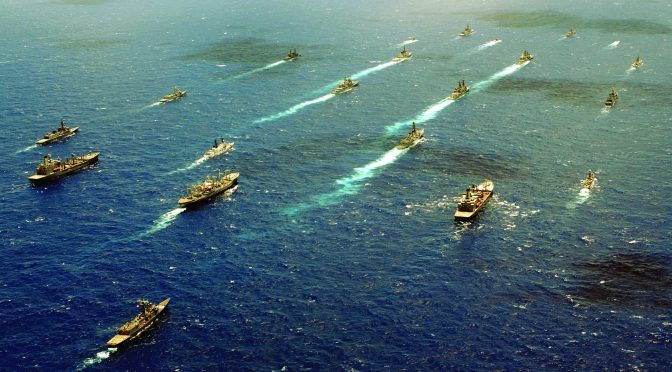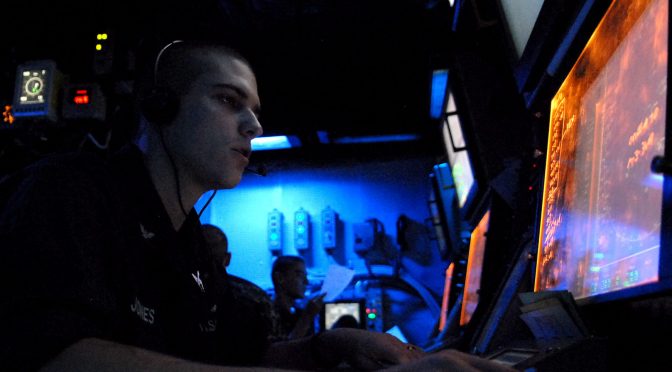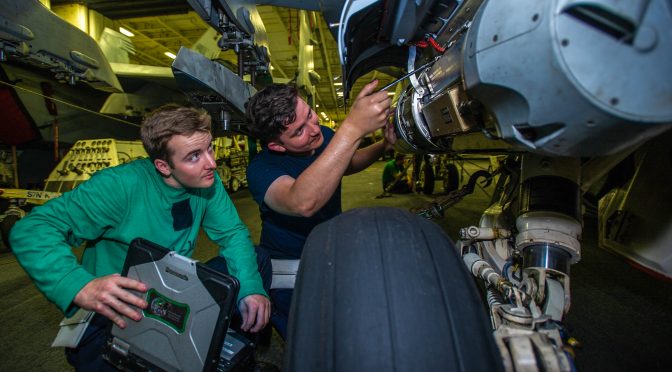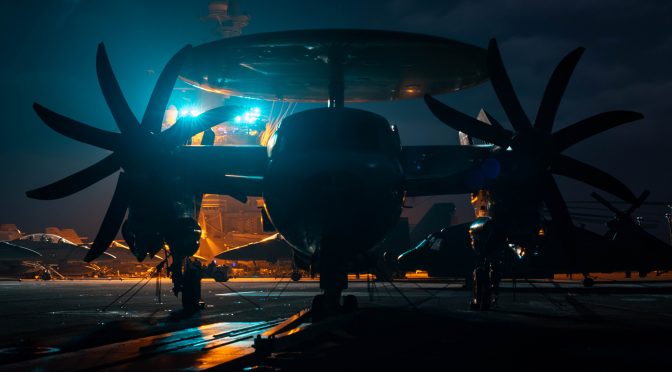Sea Control Topic Week
By LCDR Damien Dodge
Rapidly maturing electromagnetic technology will revitalize U.S. Navy combat potential and enhance opportunities to establish sea control. As the new National Security Strategy aptly illustrates the United States is faced with resurgent great power competition. Simultaneously, the Joint Operating Environment of 2035 portends a future influenced by the proliferation of disruptive and asymmetric capabilities engendered through global advances in “science, technology, and engineering” expanding the innovation horizons of “robotics, Information Technology, nanotechnology and energy.”1 The Intelligence Community’s Worldwide Threat Assessment reinforces this view and highlights aggressive competition due to adversary advances in high-impact dual-use technologies. The creation of Google’s Artificial Intelligence (AI) center in Beijing and China’s recent testing of its “quantum satellite” followed by its rumored fielding of an at-sea railgun offer practical demonstrations of this outlook.2 Furthermore, retired Marine General John Allen and Amir Husain envision “hyperwar,” in which the future battlespace will churn with cross-domain action and counteraction at speeds nearly eclipsing human capacity for comprehension and reaction.3
Within the context of this near-future operating environment, current maritime Information Warfare (IW) capabilities, such as those contributing to Signals Intelligent (SIGINT), Electromagnetic Maneuver Warfare (EMW), Electronic Warfare (EW), and communications, do not afford sufficient operational agility or adaptability to gain advantage over or exploit the weaknesses of adversaries. Adversaries that are bent on projecting overlapping and reinforcing domains of combat power near their national shores could overwhelm and exploit seams in current Navy electromagnetic-dependent capabilities.
Given this challenging, hypercompetitive environment the Chief of Naval Operations’ Design for Maintaining Maritime Superiority confronts this problem head-on. The CNO seeks to “strengthen naval power at and from the sea” and also to “advance and ingrain information warfare” capabilities across the Navy. This is to enable maritime commanders to achieve objectives through multi-domain maneuver and control “in a highly ‘informationalized’ and contested environment.”4 Additionally, the “Surface Force Strategy: Return to Sea Control” echoes the CNO’s direction by promoting “Distributed Lethality,” which advocates for “increasing the offensive and defensive capability of individual warships, employing them in dispersed formations across a wide expanse of geography, and generating distributed fires.” This is complemented by Defense Department officials advocating for human-machine teaming and an explosion in fielding unmanned systems. Finally, this accelerating competition compels the CNO to advocate not only for a larger fleet, but also one which “must improve faster” where “future ships… [are] made for rapid improvement with modular weapons canisters and swappable electronic sensors and systems.”5
Fortunately, rapid advances in technology, beyond solely enabling adversaries, can also support the CNO’s vision for the Navy – especially one primed to rapidly integrate and learn. With the advent of new designs for antennas and Radio Frequency (RF) components, the evolution of Software Defined Radios (SDR), and more practical instantiations of Artificial Intelligence (AI), these technologies can now be innovatively combined to operationalize envisioned, but not yet fully realized, IW and EMW warfighting capabilities. The capability nexus formed by these swiftly maturing technologies affords the Navy an unparalleled opportunity to maintain cross-domain battlespace decision superiority while outpacing and seeding uncertainty within an adversary’s decision cycle. To achieve this, the Navy must leverage longstanding research investments and aggressively transition these technologies from Defense Advanced Research Project Agency (DARPA) programs, Federally Funded Research and Development Center (FFRDC) initiatives, Office of Naval Research (ONR) workbenches, and warfighting center laboratories into fully integrated naval systems. These transitions will provide warfighters the needed tools and decision aids to dynamically control their electromagnetic signatures, provide optimal and low probability of detection communications, deliver more effective Electronic Warfare (EW) capabilities, revitalize signals intelligence collection, and engender greater freedom of action across the electromagnetic spectrum. This enabling electromagnetic superiority will present expanded opportunities for maritime commanders to seize sea control at times and places of their choosing.
Emerging Options and Tools in the Electromagnetic Domain
Antennas and RF components accomplish many functions on a navy ship. These functions are traditionally performed by dedicated single-role RF apertures and components which operate radars, transmit or receive communications, establish tactical datalinks, collect adversary communication signals, and detect or electronically frustrate threat sensors. This stovepipe approach to accessing and influencing the electromagnetic spectrum has created warships bristling with single-purpose antennas awash in scarcely manageable electromagnetic interference (EMI) and subject to individualized, byzantine maintenance and logistic support tails. This situation is a contributing factor to the complexity of the Navy’s C5I architecture afloat, which VADM Kohler admitted requires a 50-person team at the cost of one million dollars to make a Carrier Strike Group fully effective prior to deployment.6 Also, when new capabilities are fielded, such as the F-35, existing systems are often not sufficiently adaptable to absorb their advanced capabilities. Marine Commandant General Robert Neller highlights this issue when lamenting the Marine Corps’ inability to benefit fully from the F-35’s sensors due to Navy amphibious ships being unable to optimally communicate with the aircraft.7 Additionally, shipboard antenna thickets create a significantly larger radar cross section (RCS), thus illuminating these ships to adversary active sensors. Finally, this collection of standalone systems complicates the ship’s ability to manage its electromagnetic emissions in order to hide from passive threat sensors and often the only option may be a tactically dissatisfying binary approach: gain battlespace awareness and communicate, or hide from the adversary.
In contrast to this patchwork approach, more open architecture (OA) and dynamic phased array antennas combined with advanced element-level RF components are improving beamforming parameters. These include very low sidelobes and extended frequency range dynamics of RF system apertures as revealed by even superficial scans of Defense Technical Information Center (DTIC), Institute of Electrical and Electronics Engineers (IEEE), and International Telecommunication Union (ITU) websites.8 Georgia Tech Research Institute’s agile aperture antenna technology exemplifies these burgeoning capabilities.9 These capabilities could enable various, low-RCS antenna arrays to perform and synchronize a multitude of electromagnetic functions – evidenced by the Zumwalt class destroyer’s smooth exterior. Separate antenna array elements could form directional, purposeful transmitting or receiving beams pointing to traditional satellites, CubeSats, Aquila-like aircraft, UAVs, or other warships while other array elements establish links or sense the environment.10 These various arrays and elements would be kept from interfering with each other by orchestrating their assigned tasks across temporal (transmission timing), spectral (frequency allocation or waveform selection), and spatial (which element and/or beam) dimensions, or some combination thereof.
For example, an antenna array on the forward part of the ship could switch duties with those on the aft, thus eliminating cut-out zones and distracting ship maneuvers such as steering a “chat-corpen,” which is slang for a ship heading that will maintain satellite communications (SATCOM). Adjustable transmission power and frequency settings combined with narrower beamforming options may offer additional satellite pointing opportunities or improved low-on-the-horizon aircraft communications, while reducing probability of detection or interception by an adversary. Low power, narrow horizontal beams designed for intra-strike group communications could also multi-statically search for surface contacts – referred to in academic journals as “radar-communication convergence.”11 A majority of shipboard spectrum access and sensing could be performed through a more standardized and harmonious set of advanced interconnected antenna arrays, despite the remaining need for distinct electromagnetic array systems such as Aegis or Surface Electronic Warfare Improvement Program (SEWIP), which are beyond near-term integration into this concept due to their highly specialized functions. Nevertheless, more capable and dynamic antenna arrays and RF components are a source of increased efficiency, greater operational agility, and a potential aperture to confuse adversaries while maximizing friendly communications and sensing.
A necessary complement to advanced antennas and RF components is the flexibility of SDRs and their associated digital signal processing (DSP) capabilities. SDRs can accomplish a wide variety of functions previously relegated to system-specific hardware by using devices such as field-programmable gate arrays (FPGA) and more generalized, or even virtualized, computing platforms.12 Together these systems can generate, process, store, and share digital data about signals, either for transmission or upon reception. SDRs can generate waveforms electronically-molded for multiple purposes, allowing for backend DSP to differentiate the signal transmissions and, if combined with radar, reflected returns, maximizing the information recovery from each emitted electromagnetic field.
Evolving SDR performance is establishing the foundation for advanced capabilities such as cognitive radio or radar. “Cognitive” in this usage simply implies a capability designed to sense the electromagnetic environment and determine times and frequencies that are being underused, offering an opportunity for use by the system, which is also known as dynamic spectrum access.13 The concept was conceived as a way to achieve more efficient use of the commercial frequency spectrum, given its increasing congestion, but it also has obvious military applications. For example, if a frequency-hopping system was detected in an area, then a cognitive radio could hop to a different sequencing algorithm, or if a radar was sweeping the spectrum at a certain periodicity, a cognitive radar could sweep at a synchronized offset and use both returns for a more refined depiction of contacts in the area. There are even proposals where radar can work collaboratively with cellular signals to detect contacts with a low probability of interception.14 This could be a useful capability during stealthy naval littoral operations. Additionally, within the bounding parameters of the antenna arrays and RF hardware components, new waveform generation only requires a software update enabling an SDR to facilitate communications with new capabilities such as the F-35, a newly launched CubeSat, a friendly unmanned system, a newly arrived coalition partner, or a recently invented low probability of detection waveform designed to defeat the adversary’s latest sensing algorithm.
The more ambitious and final ingredient necessary to achieve improved IW and EMW capabilities is a form of AI designed for electromagnetic applications and decision support. It is obvious from the contributing authors to the recent ITU Journal special issue, The impact of Artificial Intelligence on communication networks and services that Chinese research and innovation is also trending in this direction.15 While SDRs are powerful tools, they could be improved by orders of magnitude through use of AI algorithms such as those derived from Game Theory and Bayesian mathematics.16 SDRs can perform DPS and waveform generation, but AI or machine learning algorithms can assist in orchestrating enhanced scanning and sensing, thus providing the right signals or portions of the spectrum at the right time to the SDRs for DSP and information extraction. In other words, AI could perform higher-level operations such as altering the application of DSP procedures and determining when and how best to sense and exploit underused, or purposefully below the noise floor, portions of the spectrum. AI could also link the myriad permutations of waveform possibilities to operational objectives such as prioritizing air defense electromagnetic sensor processing and EW protection during an engagement, minimizing adversary emission detection opportunities during a raid, or contributing to adversary uncertainty through deliberately misleading emissions during deceptive maneuvers. Together, these capabilities crowned with practical AI implementations could contribute toward easing many tedious, human-speed and error-prone activities used to achieve IW and EMW capabilities. These human errors include hurried and disjointedly setting emissions control, establishing overly static yet fragile communications plans, divining optimal radar configurations, or communicating haphazardly with coalition partners. Empowered with AI-enabled automation and decision aids, a more integrated and homogenous approach using advanced antenna arrays and SDRs to access and sense the spectrum would vastly improve electromagnetic freedom of action and decision superiority. Thus, if the Navy desires to seize sea control when and where she chooses, first establishing electromagnetic spectrum control is a warfighting prerequisite.
Conclusion
All worthwhile visions of the future confront challenges and resistance, and this one is no different. Legacy antennas, components, radios, and architecture litter numerous program offices, each with differing objectives. Therefore, the Navy must diligently work to coordinate deliberate whole-of-Navy modernization schemes that leverage open architecture, emphasize interoperability, and prioritize these technologies in pursuit of this vision’s goals. Beneficially, the Naval Surface Warfare Center Dahlgren Division’s Real Time Spectrum Operations (RTSO) and ONR’s Integrated Topside initiative are laboring toward these ends.17 Also, various DARPA activities such as Signal Processing at RF (SPAR), Shared Spectrum Access for Radar and Communications (SSPARC), and Communications Under Extreme RF Spectrum Conditions (CommEx), Advanced Wireless Network System (AWNS), and the Spectrum Collaboration Challenge (SC2) together create a rich portfolio of experience and opportunity awaiting renewed Navy focus and attention.18 Furthermore, it will be critical for the Navy to establish an ecosystem, either contracted as a service or as a core, in-house function, in support of continuous SDR software Development and Operations (DevOps) and AI algorithm development.19 This will enable the Navy to continually pace electromagnetic congestion and adversary competition.
Agilely designed, open architecture antenna arrays and RF components connected to dynamic SDRs and empowered by AI algorithms can revitalize and ingrain IW and EMW warfighting capabilities across the Navy to allow the force to confidently seize sea control and win in the future maritime battlespace. Collectively, these capabilities could bring about currently fanciful opportunities, such as a strike group secretly transiting at night through fishing grounds using radio communications imperceptibly different from the fishing trawlers. Such a strike group could employ both intra-strike group communications and surface search radar while receiving and sending intelligence via recently launched CubeSats transmitting on waveforms indistinguishable with area freighters’ Very Small Aperture Terminal (VSAT) satellite communication links, thus remaining electromagnetically camouflaged while maintaining battlespace awareness and communications. Meanwhile, cognitively networked strike group assets could passively sense and target the adversary’s emissions, enabling distributed but converging fires from distant unmanned platforms across the area of operations. Electromagnetic control establishes the initial conditions for sea control.
Lofty tactics and operations will perform sub-optimally and be disrupted through electronic attack unless the Navy builds a solid foundation in electromagnetic freedom of action. Fortuitously, these technologies creatively combined will lay the keel of advanced naval warfighting upon which future naval success will be built, launching a powerful, tough, and confident Navy into the turbulent waters of great power competition to seize sea control when and where she chooses.
LCDR Damien Dodge is a U.S. Navy cryptologic warfare officer assigned to the staff of Supreme Allied Commander Transformation, NATO. He welcomes your comments at: [email protected]. These views are his alone and do not necessarily represent any U.S. or Allied government or NATO department or agency.
References
[1] Joint Operating Environment 2035: The Joint Force in a Contested and Disordered World, Joint Staff, 14 July 2016, pp. 15-20. http://www.jcs.mil/Portals/36/Documents/Doctrine/concepts/joe_2035_july16.pdf?ver=2017-12-28-162059-917
[2] Daniel R. Coats, “Worldwide Threat Assessment of the US Intelligence Community,” 11 May 2017, https://www.dni.gov/files/documents/Newsroom/Testimonies/SSCI%20Unclassified%20SFR%20-%20Final.pdf
and, Reuters, “Chinese quantum satellite sends ‘unbreakable’ code,” Reuters.com, 10 August 2017, https://www.reuters.com/article/us-china-space-satellite/chinese-quantum-satellite-sends-unbreakable-code-idUSKBN1AQ0C9 and, Shelly Banjo and David Ramli, “Google to Open Beijing AI Center in Latest Expansion in China,” Bloomberg.com, 12 December 2017, https://www.bloomberg.com/news/articles/2017-12-13/google-to-open-beijing-ai-center-in-latest-expansion-in-china
[3] GEN John R. Allen, USMC (Ret.), and Amir Husain, “On Hyperwar,” U.S. Naval Institute Proceedings 143, no. 7 (July 2017), 30–37.
[4] A Design for Maintaining Maritime Superiority, Chief of Naval Operations Staff, Version 1.0 January 2016. Available at, http://www.navy.mil/cno/docs/cno_stg.pdf
[5] “The Future Navy,” 17 May 2017, http://www.navy.mil/navydata/people/cno/Richardson/Resource/TheFutureNavy.pdf
[6] Sydney J. Freedberg Jr., “Navy Kludges Networks: $1M Per Carrier Strike Group, Per Deployment,” Breaking Defense, 12 February 2018, https://breakingdefense.com/2018/02/navy-kludges-networks-1m-per-carrier-strike-group-per-deployment/?_ga=2.90851354.1645113230.1518436630-2104563909.1489661725
[7] Mike Gruss, “Three tech problems the Navy and Marines are worried about,” C4ISRNET, 8 February 2018, available https://www.c4isrnet.com/show-reporter/afcea-west/2018/02/08/three-tech-problems-the-navy-and-marines-corps-are-worried-about/
[8] Examples include: James J. Komiak, Ryan S. Westafer, Nancy V. Saldanha, Randall Lapierre, and R. Todd Lee “Wideband Monolithic Tile for Reconfigurable Phased Arrays,” available http://www.dtic.mil/dtic/tr/fulltext/u2/1041386.pdf and Benjamin Rohrdantz, Karsten Kuhlmann, Alexander Stark, Alexander Geise, Arne Jacob, “Digital beamforming antenna array with polarisation multiplexing for mobile high-speed satellite terminals at Ka-band,” The Journal of Engineering, 2016, 2016, (6), p. 180-188, DOI: 10.1049/joe.2015.0163 IET Digital Library, http://digital-library.theiet.org/content/journals/10.1049/joe.2015.0163 and Darren J. Hartl, Jeffery W. Baur, Geoffrey J. Frank, Robyn Bradford, David Phillips, Thao Gibson, Daniel Rapking, Amrita Bal, and Gregory Huff, “Beamforming and Reconfiguration of A Structurally Embedded Vascular Antenna Array (Seva2) in Both Multi-Layer and Complex Curved Composites,” Air Force Research Laboratory, AFRL-RX-WP-JA-2017-0481, 20 October 2017, available http://www.dtic.mil/dtic/tr/fulltext/u2/1042385.pdf
[9] GTRI Agile Aperture Antenna Technology Is Tested On An Autonomous Ocean Vehicle … https://www.rfglobalnet.com/doc/gtri-agile-aperture-antenna-technology-autonomous-ocean-vehicle-0001
[10] Aquila is a Facebook project to develop a high-altitude, long-endurance (HALE) solar-powered UAV “that the company envisions one day will provide wireless network connectivity to parts of the world that lack traditional communication infrastructure.” Steven Moffitt and Evan Ladd, “Ensure COMMS: Tap Commercial Innovations for the Military,” U.S. Naval Institute Proceedings 143, no. 12 (December 2017), 54-58.
[11] Bryan Paul, Alex R. Chiriyath, and Daniel W. Bliss, “Survey of RF Communications and Sensing Convergence Research,” IEEE Access, date of publication December 13, 2016, date of current version February 25, 2017, Digital Object Identifier 10.1109/ACCESS.2016.2639038 available http://ieeexplore.ieee.org/stamp/stamp.jsp?arnumber=7782415
[12] Mike Lee, Mike Lucas, Robert Young, Robert Howell, Pavel Borodulin, Nabil El-Hinnawy, “RF FPGA for 0.4 to 18 GHz DoD Multi-function Systems,” Mar 2013, http://www.dtic.mil/dtic/tr/fulltext/u2/a579506.pdf
[13] Helen Tang and Susan Watson, “Cognitive radio networks for tactical wireless Communications,” Defence Research and Development Canada, Scientific Report, DRDC-RDDC-2014-R185, December 2014, available http://www.dtic.mil/dtic/tr/fulltext/u2/1004297.pdf
[14] Chenguang Shi, Sana Salous, Fei Wang, and Jianjiang Zhou, “Low probability of intercept-based adaptive radar waveform optimization in signal-dependent clutter for joint radar and cellular communication systems,” EURASIP Journal on Advances in Signal Processing, (2016) 2016:111, DOI 10.1186/s13634-016-0411-6, available https://www.ncbi.nlm.nih.gov/pmc/articles/PMC5085998/
[15] ITU Journal, ICT Discoveries, First special issue on “The impact of Artificial Intelligence on communication networks and services,” Volume 1, No. 1, March 2018, available, https://www.itu.int/dms_pub/itu-t/opb/tut/T-TUT-ITUJOURNAL-2018-P1-PDF-E.pdf
[16] Jan Oksanen, “Machine learning methods for spectrum exploration and exploitation,” Aalto University publication series, Doctoral Dissertations 169/2016, 21 June 2016 Unigrafia Oy, Helsinki, Finland, 2016, available
https://aaltodoc.aalto.fi/bitstream/handle/123456789/21917/isbn9789526069814.pdf?sequence=1 and Helen Tang, et al.
[17] Gregory Tavik, James Alter, James Evins, Dharmesh Patel, Norman Thomas, Ronnie Stapleton, John Faulkner, Steve Hedges, Peter Moosbrugger, Wayne Hunter, Robert Normoyle, Michael Butler, Tim Kirk, William Mulqueen, Jerald Nespor, Douglas Carlson, Joseph Krycia, William Kennedy, Craig McCordic, and Michael Sarcione, “Integrated Topside (InTop) Joint Navy–Industry Open Architecture Study” Naval Research Laboratory, Sponsored by Office of Naval Research, 10 September 2010, NRL/FR/5008–10-10,198 available http://www.dtic.mil/get-tr-doc/pdf?AD=ADA528790 and, John Joyce, “Navy Expands Electromagnetic Maneuver Warfare for ‘Victory at Sea,’” U.S. Navy, 11/2/2017, Story Number: NNS171102-14, http://www.navy.mil/submit/display.asp?story_id=103165
[18] See DARPA research at https://www.darpa.mil/our-research and, Helen Tang, et al. and John Haystead, “Big Challenges Ahead as DOD Tries to Address EMSO Implementation,” Journal of Electronic Defense, February 2018 pp 22-25; and DARPA’s SC2 site https://spectrumcollaborationchallenge.com
[19] Possibly a sub-ecosystem within OPNAV’s Digital Warfare Office (DWO).
Featured Image: Operations Specialist 2nd Class Matthew Jones, from Victorville, Calif., stands watch in Combat Direction Center aboard the forward-deployed aircraft carrier USS George Washington (CVN 73). (U.S. Navy photo by Chief Mass Communication Specialist Jennifer A. Villalovos/Released)




